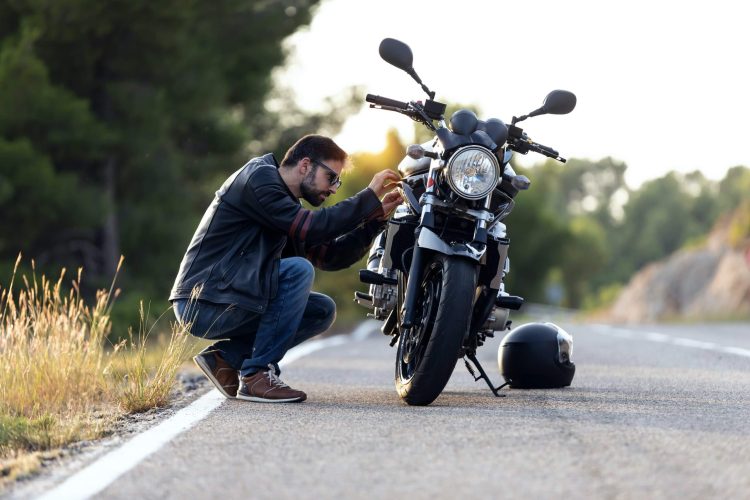
If you’re looking to get something smaller than a car but faster than a bicycle, a motorcycle or scooter could be right up your alley. There are benefits of both vehicles and things that may not be right for you. Here’s a breakdown of the pros and cons of both.
Scooter
Scooters, also known as motor scooters, are low-speed motorcycles with a step-through frame and a platform for the rider’s feet. Scooters are sometimes confused with kick scooters or mopeds, but the main difference is mopeds and kick scooters are propelled by the person riding them, not a motor.
Pros of a Scooter:
Ease of Use
Integral to the design of a scooter is its step-through frame and platform, which means mounting a scooter couldn’t be easier. They are also generally lower to the ground and generally lightweight. Most scooters have automatic transmissions, so you simply turn them on and go—no need to learn how to use a clutch or shift gears.
Low Cost
Not only are scooters affordable to purchase, ranging from a few hundred dollars to a few thousand, but they also get great gas mileage. In a comparison of over 5500 bikes from 1934 to today by Total Motorcycle, scooter mileage ranged from 85-157 mpg. Tires often last longer and are cheaper to replace on scooters, and they generally require less maintenance. Insurance rates are usually affordable, too.
Maneuverability
When people think of scooters, they usually think of people whipping around traffic or motoring down small alleyways in Europe. That’s because they gained in popularity during post-World War II when the Vespa and Lambretta models were introduced in Italy. Their smaller wheelbase makes for better maneuverability and turning. Scooters are nimble and small enough to squeeze through tight spaces and can be parked virtually anywhere.
Cons of a Scooter
Unstable & Uncomfortable
While their small tires make them easy to maneuver, it also means they’re not suited for rough terrain. The seats and your body position on the scooter can also become uncomfortable after a long trip.
Can’t Ride It Everywhere
Scooters are not designed for speed, and many of them are not capable of hitting highway speeds. In fact, some states and cities do not allow scooters on interstate highways or freeways. This means you may have to find alternate routes when traveling.
Safety Concerns
Scooters can be very quiet, meaning other drivers on the road may not see or hear you coming. They also do not have seatbelts, so you must stay alert and steady to prevent a fall. Since there is no protective frame to a scooter, helmets are highly suggested and required in some states.
Motorcycle
Motorcycles are two or three-wheeled motor vehicles that require the rider to straddle the vehicle, like a bicycle. According to Kelly Blue Book, there are three primary types of motorcycles: off-road, street, and dual-purpose. Many different subsets within each of these three categories can be used for a wide array of purposes.
Pros of Motorcycle:
Speed
The fastest motorcycle ever produced, the 2003 Dodge Tomahawk, was said to be able to reach 300 mph (luckily, no one has ever tested that). Today’s average motorcycles can go just as fast as cars, some even faster. This means motorcycles can handle highways and freeways just fine.
Stable and Comfortable
A longer wheelbase and larger tires make motorcycles more stable at higher speeds. Since many people make cross-country trips in them, many motorcycles, particularly touring motorcycles, are designed to be comfortable for long periods.
Lots of Options
Adventure bikes. Sportbikes. Cruiser. Dual Sports. Dirt Bikes. Supermotos. There are many types of motorcycles for all kinds of riders, terrain, and purposes. They can also come with various features, like cruise control, high-quality speakers, and hill-start assist.
Cons of a Motorcycle
High Cost
Motorcycles can cost anywhere from a few thousand dollars for a used motorcycle to tens of thousands and up for ultra-luxury models. Newer bikes can get good gas mileage, from 50-125 mpg, but the heavier the bike, the less it will get. Insurance and maintenance costs are typically higher for motorcycles as well when compared to a scooter.
Loud & Clunky
Motorcycles are known for their roaring engines, which can become a nuisance in certain areas. Due to their longer wheelbase, motorcycles have less precise maneuvering and turning, especially at low speeds.
Higher Risk
Motorcycles are less visible to other drivers and pedestrians and less stable than four-wheel vehicles. According to the National Highway Traffic Safety Administration, in 2018, motorcyclists were 27 times more likely than passenger car occupants to die in a crash per vehicle miles traveled.
Whether you decide to zip off in a scooter or hit the open road in a motorcycle, you’ll need insurance to stay protected. Freeway Insurance can find you great rates on motorcycle insurance or scooter insurance coverage. Request a motorcycle insurance quote online, over the phone, or at one of our offices near you. A quote from Freeway Insurance allows you to compare motorcycle insurance costs across multiple motorcycle insurance companies.



